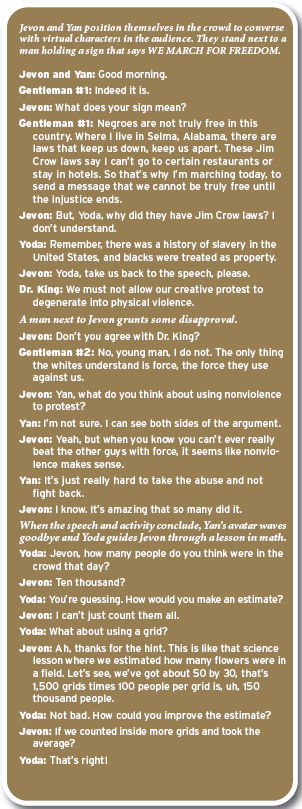
Imagining life far off in the future is the stuff of science fiction. Imagining life a few decades from now, however, is a subject of serious inquiry for military strategists, urban planners, and marketers. Why not for educators?
In the following pages, we sketch a vision of learning that may seem “gee whiz” but which is grounded in technologies—for visual display, interaction, content creation, learning science, virtual reality, and more—that exist or are in development today. (See Technology Notes for a sample of companies and products.)
We envision 10-year-old Jevon learning, in his home, a history lesson that is suited to his learning level yet has the capacity to challenge him, creates opportunities for interdisciplinary study of critically important content and skills, and encourages independent thinking and exploration. This 2025 immersive learning environment is not unlike interactive globally connected games such as World of Warcraft, Second Life, and others that today engage children and teens in roleplaying, strategizing, and mock battles. Students in each 3D world speak, type, touch the screen, and use handheld controllers to explore and become part of the eras and subjects they study, interacting with real and synthetic people, places, and scenes.
Within a wide array of these worlds, learners master common core sets of objectives at a pace that suits them, guided and encouraged by an avatar (an appealing virtual character operated by a computer) who engages the student in ongoing conversation. In our example, Jevon has fashioned his teacher avatar from a character named “Yoda” he had seen in an old movie.
As they work to mastery, students can explore related side topics via hyperlinks and interactions, while the pacing and guidance systems ensure a complete curriculum is covered in an effective sequence. Using the tools of artificial intelligence together with data gathered from watching this learner and millions of others, the system over time comes to “understand” the style, capability, and learning history of each student, and uses that understanding to adjust activities and pacing.

Jevon’s Experience
Regardless of students’ physical location, they can learn with friends and peers from around the world. Yan, an 11-year-old girl from a city near Beijing, China, joins Jevon as he listens to Dr. Martin Luther King Jr. deliver his “I Have a Dream” speech. Automatic language translation enables the two students to interact in real time. Jevon and Yan position themselves in the crowd to converse with virtual characters in the audience. In the side bar, we continue the dialogue, imagining how Jevon and Yan might interact with each other, with characters from the history they are studying, and with the teaching avatar Yoda.
After one set of objectives has been met, the system can use the same 3-D environment for other goals, such as learning to estimate. Any single objective can appear in many contexts, promoting creative and flexible triggering of ideas and skills, exactly how instructional expertise is supposed to benefit learners in the real world.
Students can work together via webcam and avatar, all monitored and recorded for security and analysis. They can work in groups of a particular age or learning level, sharing and manipulating materials together, discussing what they are learning. The use of avatars may ease the potential awkwardness of a particularly advanced 10-year-old, for example, working with older students in some subjects.
The system can be accessed anytime. Younger children, teenagers, and adults all have different sleep and learning cycles; a teenager may prefer literature discussions at 4 PM and math at 11 PM. There will always be countless students available for collaboration.
Periodically, depending on Jevon’s progress and needs, an educator-advisor or academic “coach” spends time reviewing his results, monitoring his system usage (perhaps targeting particularly difficult and important concepts and skills for Jevon), and sending feedback to Jevon’s parents.
A System That Learns
The system leverages data from millions of learners individually experiencing thousands of learning activities each year. Similar to how today’s Google, amazon.com and Last.fm work, after each of Jevon’s interactions with Yoda, the system can compare his responses to those of his peers within this vast database. If Jevon had struggled with estimating the size of the crowd, the system would add this to the database. At the same time, the system would draw on information about similar learners to help Jevon master the material; the avatar would use an educator’s guiding question that had helped similar students apply estimation techniques.

Driven by Educators
Educators create content and activities for the system based on the targeted skills and concepts in each subject area, what is known about how children learn (from neural imaging and studies of typical development sequences), and what is understood to be effective for teaching specific topics (from deep databases of histories organized by learner characteristics). The content is peer reviewed and field tested. As information flows in from hundreds of thousands of children, educators are able to see what activities work best for children with different learning histories, and adjust the content (who sees what, and what they do) to optimize instruction for each type of child. There is no “standard” learning sequence, although each version targets the same underlying objectives.
Beyond creating content, educators participate in various ways: reviewing student performance that the system has flagged as needing attention, giving one-on-one or one-to-many instruction, either virtually (mostly) or in person for children for whom in person learning is optimal. Teachers can take up roles within simulations or inhabit virtual tutors for specific topics; they can also manage “community time” activities, in person or virtually. Like today’s busy children, learners schedule real world social interaction into the school day or week. Kids from the local area may play games and sports, practice music, or put on skits and plays.
An education system such as we have envisioned here is closer than you might think. Growing understanding about how students learn, together with technologies that are already engaging children and technologies now in development, will soon enable educators to customize each child’s learning experiences to make them more enjoyable and more effective.
| Technology Notes
Growing understanding about how students learn, together with technologies that are already engaging children and technologies in development, such as those listed below, will enable educators to customize each child’s experience to optimize learning. Multitouch Displays: Microsoft Surface is planning to start with commercial applications but head for the home. www.microsoft.com/surfaceJeff Han from New York University has started a company to market his wall-sized multitouch displays. www.perceptivepixel.com Telepresence: Life-sized images in high definition for video conferencing.HP Halo. www.hp.com; Cisco TelePresence. www.cisco.com 3-D Immersive Environments: Second Life. www.secondlife.comThe Sims game (sample movie from a contest). thesims2.ea.com/contests/winners/RunnerUp_newbeginnings.wmv World of Warcraft. www.worldofwarcraft.com/wrath/ulduar.xml Collaborative Filtering: Google, Amazon, NetFlix, Last.fm all use such systems to analyze taste and interest data from millions of people to make more accurate recommendations. Super Crunchers: Why Thinking-by-Numbers Is the New Way to Be Smart by Ian Ayres reports on the “crunching” of massive amounts of data. Natural Language Processing: Dragon NaturallySpeaking handles normal speed continuous speech dictation (converting voice into text) but does not “understand” what the speaker is saying. Truly conversational systems are still years away. www.nuance.com/naturallyspeaking Intelligent Software: MIT Media Lab is working on “intelligent agents” that have common-sense understanding. www.media.mit.edu/research/23CyberTwin is marketed as a “software clone.” mycybertwin.com Converting Pictures to 3-D Virtual Spaces: Microsoft has Photosynth technology that is starting down this path. photosynth.netUpNext generates 3-D city views from aerial photos. www.upnext.com Educational Simulations: Henry Leitner of Harvard University presented “Innovations in Online Education: 3D Virtual Worlds, Gaming and Simulation” at the 2007 University Continuing Education Association conference. See also “Virtual Reality/Simulations” by Nicole Strangman & Tracey Hall, National Center on Accessing the General Curriculum, 2003 (paper). www.cast.org/publications/ncac/ncac_vr.html Immersive elearning: Minneapolis-based elearning company w/ uses avatars and 3D environments to create immersive learning courses that help businesses simulate real-world scenarios in which employees can practice selling techniques and master social situations. www.wslash.net |
Gerald Huff is director of the Technology Innovation Group at Intuit, Inc. Bror Saxberg is chief learning officer at K12, Inc., a creator and manager of online learning curricula and programs serving both public and private customers.


